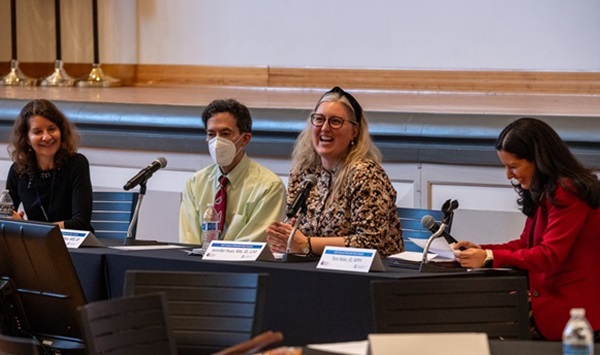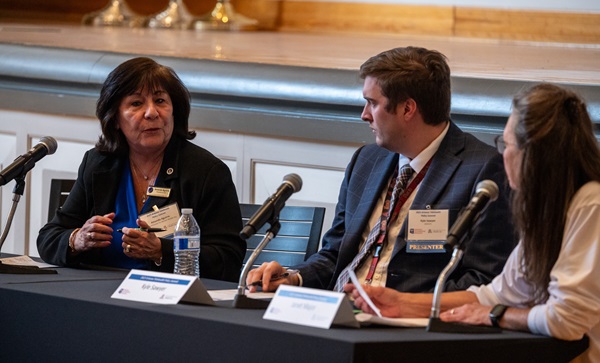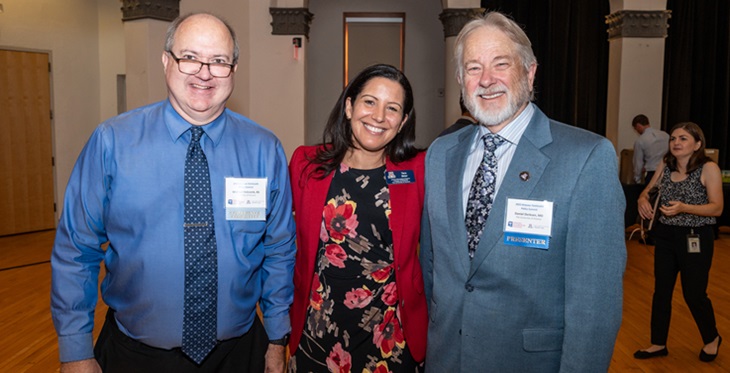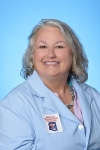The 2023 Arizona Telehealth Policy Summit kicked off its first in-person gathering since the pandemic with more than 130 people, 70 people in-person in Phoenix, and more than 60 others viewed the live video stream from remote locations.
“This is our fourth summit, but the first one we've had in-person with a virtual option since the public health emergency,” said Tara Sklar, associate director of Telehealth Law and Policy with the Arizona Telemedicine Program and director of the Health Law and Policy Program at University of Arizona College of Law. “It’s a very special day for us.”
Sklar welcomed Dr. Carlos Conzales, assistant vice president of Indigenous Affairs for the Global MD program at University of Arizona Health Sciences, who officially opened the summit with a blessing and land acknowledgement.
“I will wish you the best at your conference,” Gonzalez said. “… bless you in your discussions, so that you have a good summit, and you can come out with good policy that will help your fellow human beings in our country for that is what your purpose is.”
Growing physicians, grows the economy
Dr. Dan Derksen, associate vice president for health equity, outreach and interprofessional activities at the University of Arizona Health Sciences, provided welcoming remarks by painting a picture of Arizona that illustrated its unique population and healthcare needs.
“Our population growth has been so extraordinary as well as our economic growth over time. I'd like to focus on our unique state Medicaid program, the Arizona Healthcare Cost Containment System, and then how that connects to some of our health workforce challenges that we have in our state, and some of the recommendations perhaps for this next 2024 legislative session,” said Derksen.
One of the challenges partially addressed in the last state Legislative session is the cap on Medicare subsidies for medical school students. Derksen said that for being 14th in the country per population, Arizona is 40th in the country in physicians. And Arizona doesn’t have enough graduate medical school slots to address all the healthcare needs of our population.
One of the benefits of paying close attention to population growth and medical school growth is the importance it plays in economic growth. For example, when a physician establishes their practice in a rural area, over 20 jobs are created.
Telehealth Policy and the Arizona State Legislature
The summit included three panel discussions, beginning with state legislators , nationally recognized health law scholars, and broadband and digital navigation leaders. Marc Miller, dean of the University of Arizona James E. Rogers College of Law, moderated the first panel with state Senator T.J. Shope, and state Representatives Alma Hernandez and Patty Contreras. 
Before introducing the state legislators, Miller noted how HB 2454, Arizona legislation signed into law in May 2021, recognized the important role of telehealth as part of our healthcare system; and that two years later, lawmakers passed further legislation to allow telehealth to be accessible to all Arizonans, with payment parity for telehealth services.
“Arizona's continued position as a leader in telehealth is largely due to the commitment of our state legislators over time,” Miller said.
Representative Patty Contreras, a freshman legislator, explained that she hadn’t been part of past telehealth policy, but she appreciated its usefulness during the pandemic when she worked for the City of Phoenix, directing eight of the city’s 15 senior centers.
When the lockdown was announced, Contreras and her staff worked to digitally connect with 3,000 seniors to help them see the value of digitally connecting through the city’s own platform. Together, they created a digital community to keep seniors engaged and active.
“We nurtured their souls. We kept them together. We kept them alive. I really think that we saved lives. We really did it. We helped to save people's lives over the course of the pandemic,” Contreras said.
Senator T.J. Shope recalled how growing up in Coolidge, Arizona, often meant driving 30-60 minutes or more to see a provider. He chairs the Arizona Senate Health and Human Services committee and noted that many health issues, including telehealth, are truly bipartisan issues and that the AZ legislature has continued to build on a legacy of healthcare providership with new forms and different types of healthcare so long as they meet the needs of patients and providers.
Going forward, Shope said he’s hopeful the Legislature will continue to move forward regarding healthcare and telehealth—mentioning legislation that provided for more communication amongst senior and long-term health facilities that could benefit Arizona’s growing elderly population, especially those without family to help care for them, and the new veterinary telehealth bill that passed in Arizona this year. Representative Alma Hernandez, who concluded the first panel, recalled growing up in South Tucson and recognizing the health inequities that existed in her community—one of the reasons she pursued public health education. Hernandez said she’s found that health services, especially in relation to rural communities and addressing disparities, bring legislators together.
Paying providers for telehealth services is important to Hernandez, as well as increasing the number of medical school students in Arizona. “Let's try to keep them here, because we are, you know, using our resources and educating them here, but we also want good quality people to stay here.”
National trends reflect priorities ahead for telehealth policy
Sklar moderated the second panel on national trends in telehealth with Jennifer Huer, JD, LLM from Yale Law School, David Orentlicher, MD, JD from William S. Boyd School of Law at University of Nevada Las Vegas; and Sharona Hoffman, JD, LLM, SJD from Case Western Reserve University School of Law.
Huer presented her project, Palliative Care GPS, a database she’s helped develop the past few years to help policymakers, lawmakers, advocates and providers.
Palliative Care GPS is a database for providers, caretakers, patients and family members to gain access to telehealth information state by state on legislation and policy, providers, specialists and other palliative care needs and information. Huer said they also want to incorporate Indian Health Service and Veterans Affairs data.
Orentlicher talked about national licensure and the Uniform Telehealth Act, which could, if created and passed, expand telehealth providers coverage areas state to state. He mentioned the Uniform Law Commission, which drafts laws that are designed to bring uniformity to areas that states regulate.
In Nevada, where Orentlicher lives and works, they recently adopted a law for public health emergencies to come up with a standard to address national public health emergencies throughout the state, rather than waiting for another pandemic. He’s hoping that a Uniform Telehealth Act would help states like Nevada diagnose, treat, provide consultations and second opinions via telehealth to people in other states and vice versa.
“This Act does not address insurance coverage pay and the payment parity issue. It's just too complicated to get into insurance reimbursement issues,” he said. Critics will also bring up quality, rather than competition being the issue.
Hoffman spoke about patient reported outcome measures, an area that she and her husband had direct experience with personally. Her husband, who has Parkinsons disease, was spending a lot of time filling out long questionnaires before a doctor appointment. His tremors, as they grew more severe, made it difficult to complete the questionnaires.
“I got interested in what's going on here. I looked at the legal literature and there was nothing about patient reported outcome measures. So, I said, ‘Aha, I'm going to write an article.’ And my husband is a co-author. He's a computer science professor at Case Western. He contributed technical knowledge. This just came out in the Yale Journal of Health Policy, Law and Ethics, Hoffman said.
The questionnaires, called PROMs, patient reported outcome measures, are usually done on tablets or computers, and sometimes by handwriting. Patients are asked to provide data about their symptoms, treatment effects, and side effects.
“I think PROMs are particularly important in the context of telemedicine because you don't have the patient in front of you. You're not examining the patient, and this might be the only time that you're seeing the patient. You don't have a long history with the patient,” said Hoffman.
PROMs are gaining interest among healthcare providers and researchers, as well as the Federal Drug Administration and insurance companies. This heightened focus is driven by a shared commitment to evaluating treatment efficacy, fostering improvements, and ensuring equitable provider payments.
Hoffman said this makes choosing the right PROM questions important and challenging.
“ … because you have hundreds, if not thousands, of PROM questionnaires out there. How do you select the best one for your patient under the circumstances? The National Institute of Health has a database called PROMISE (patient reported outcome measure information system), but even on that system they have 650 questionnaires that have gotten their blessings. How do you pick the right one out of 650, let alone out of all the ones that are available?” Hoffman questioned.
Addressing these challenges involves exploring various PROM questionnaires to determine which one’s patients feel comfortable completing and that clinicians find genuinely useful. Additionally, the integration of computer adaptive technology can prove beneficial, dynamically adjusting the questionnaire length based on individual patient needs and symptomatology.
Telehealth, equity, and broadband
The final panel of the summit, Telehealth Challenges and Opportunities at the Local Level, included former senator Amanda Aguirre, president and CEO of the Regional Center for Border Health, Sandip Bhowmick, vice president of infrastructure and state broadband director at the Arizona Commerce Authority, and Kyle Sawyer, assistant director of public policy and strategic planning at the Arizona Health Care Cost Containment System.
“I would love to share with you is the fact that this panel is … is the best panel, because this is where the tire meets the road. This is how we make telehealth happen,” said Janet Major, associate director for innovation and digital health at the Arizona Telemedicine Program and panel moderator. 
Major explained that access to telehealth isn’t just about connected technology but having the ability to use that technology and empower patients to improve their own health.
Sawyer discussed community healthcare workers (CHWs) as the frontline public health worker in Arizona. CHWs are described as trusted members of the community that help people navigate the healthcare system and manage their chronic illnesses, maintain healthy lifestyles, and more.
“It hasn't been a licensed or certified program from the state level, but rather mostly grant funded and or community funded programs within local communities,” Sawyer said. “But that changed. Recently we did get the CHW voluntary certification rule which was passed and approved in November 2022. The Arizona Department of Health Services started voluntarily licensing CHWs at the end of last year.”
The number of certified CHWs has grown. As of April 1, 2023, he said the state has begun reimbursing CHW services who work for existing registered providers. “We saw the importance of these workers to our community.” For community organizations who have CHWs who have voluntarily certified with the state this is a great opportunity to be able to bill Medicaid for the services they’ve provided.
Aguirre, who followed Sawyer with more specific perspectives on rural community life, has seen the benefits of CHWs firsthand.
“Health, education, and prevention is not only from our nurses and doctors, but also from our community outreach workers,” Aguirre said. “That works because of the trust and relationship with our community, and that is valuable. I tell people it's like American Express, how do you put a value on it? You can't. You can't value the work that these individuals do. They know the community. They come from those communities. … They can teach us about the social determinants of health.”
Her service as a state Senator, and now the CEO of Regional Center for Border Health, has provided her with an understanding of how rural areas are isolated, making affordable healthcare and education challenging. The pandemic could have increased that isolation 10-fold, but telehealth helped. With a United States Department of Agriculture World Development matching grant, Aguirre’s organization purchased telemedicine equipment. They partnered with Global Med to train medical staff. This fiscal year, 142,000 patients were treated with 74,000 being telehealth visits.
The summit’s final panelist, Bhowmick, vice president of infrastructure and state broadband director at the Arizona Commerce Authority, presented virtually from his office.
“Broadband is the key piece behind, not only telecommunications, but also job creation,” he said.
Bhowmick’s office started in 2019 with a $3 million investment in three projects in Arizona. Last year was the biggest investment with $190 million in capital funding from the federal government.
“From there we invested $100 million, and we're able to pick 14 rural and six urban projects, and we are able to collect $112 million in matching funds,” he said. “So, with that $212 million investment we received 82 eligible proposals across the state. Sixty-seven were from rural counties, and 15 from urban counties. We intentionally kept Maricopa and Pima county in the urban counties, because these are the counties mostly populated, and with the best Internet connectivity possible.”
Fourteen projects were awarded funds in rural counties, and six in urban counties. In the next three years, Bhowmick said 3,300 miles of fiber connectivity will be created across the state. Seventy-three communities will have higher speed internet connectivity, and almost 500,000 people will have access to that connectivity in their households.
Sklar concluded the 2023 Telehealth Policy Summit with a reflection on the growth we’ve seen with patients using telehealth in Arizona and across the country. For virtual care to continue to grow as an option, we need to keep the discussion going around policy issues that can act as enablers of care or barriers. The Arizona Telemedicine Program provides a plethora of year-round events and extensive resources on its website and is here to answer any questions you may have about providing or receiving telehealth. We hope this Summit can serve as an annual check-in point going forward, and we look forward to seeing you in-person or online in 2024!
To view more photos of the 2023 Summit: Watch this video on Facebook.

